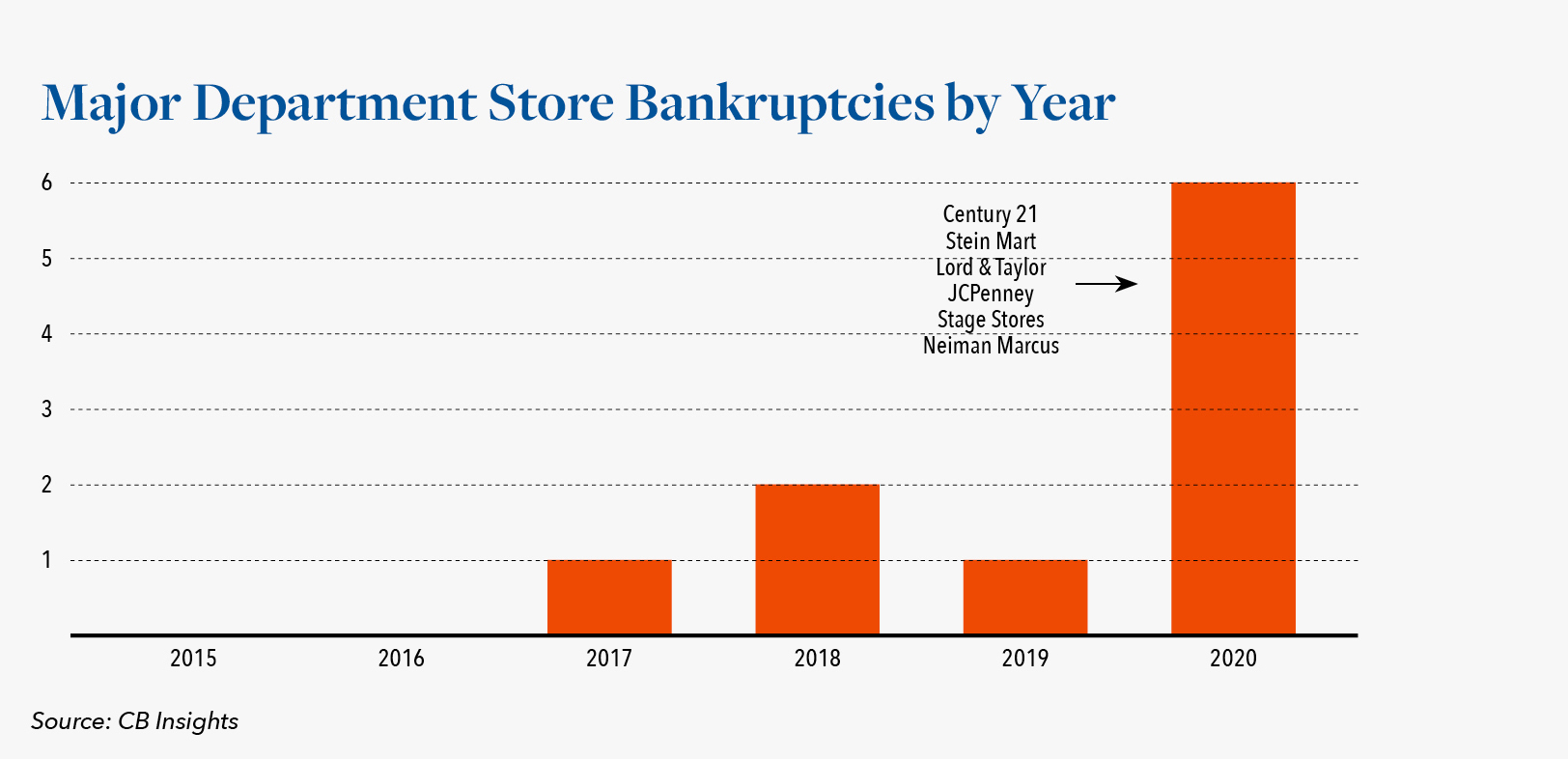Build It and People Will Come

In this article we take a look at the dilemma currently being faced by Department Store tenants, as foot traffic
continues to drop, consumer shopping trends shift and the prognosis for many regional malls is questionable. We also
explore the potential opportunities that often exist for both these tenants and their landlords when strategic and
timely action is taken.
By the time James Earl Jones uttered the words “People will come” to Kevin Costner in the popular 1989
film, Field of Dreams, the phrase was already well established as the mantra of commercial real estate developers
across the U.S.
For decades developers built, among other things, multi-million square foot regional and super-regional malls with
three to five large format, department stores supplemented by anywhere from 50-100 small-shop retailers and
restaurants. They constructed power centers with one or two retail anchors as well as a collection of mid-size
boxes, along with a smattering of small-shop tenants. And, of course, they erected neighborhood centers with a
grocery store and myriad daily needs operators. If and when developers had a project that could attract the right
anchor(s), they knew that would serve as a draw for consumers, and the higher-paying, smaller-format retailers and
restaurants would soon follow suit.

And come, they did. Now, however, in the aftermath of the dot-com era and with the proliferation of omni-channel
retailing and a worldwide pandemic that necessitated change in the way we lived our lives, a major shift has
occurred. People are shopping differently, groups like Amazon have created limitless “department stores”
on-line, and that has created a sea-change for many of the large format, traditional department stores. According to
Vox.com/recode, store revenue has dropped nearly 40% in the past dozen years, from $15.8B/ month in early 2010 to
$9.8B at the end of 2020. While some have weathered the storm, others have not, leading to an alarming rate of
closures. Meanwhile, retailers that still exist are working feverishly to reinvent themselves or determine an
evolutionary path forward for their existing businesses to adapt and avoid the fates of their lessfortunate, former
compatriots.
That said, the world of department stores has always had its comings and goings. Woolworth’s seemingly ceded to
Sears, Marshall Field’s gave way to Macy’s, while Montgomery Wards and Mervyns are a couple operators
that ceased to exist all together. Some brands, like JW Robinsons and May — and then eventually Federated
— as well as Sears and K-mart, merged with one another to try to fortify their businesses. Yet, throughout
relatively recent retail history there has usually been someone to back-fill the locations vacated by these changes
and maintain the traditional draw for their properties within regional and super-regional. While some redevelopment of these
boxes occurred, primarily over the past two decades, the marketplace has more radically changed in the more recent
past. Earlier this year, after a bankruptcy filing in 2018 and years of fighting what seemed inevitable, Sears and
Kmart completed their liquidation of all stores. Lord & Taylor filed in late 2020, after being acquired by a new
owner just the previous year. The company now exists as an online only operator, after closing all of its physical
store locations. Similarly, former department stores such as Carson Pirie Scott, Bergner’s and The Bon-Ton,
have all disappeared from the ‘brick & mortar’ marketplace in recent years, with existing operators
such as Saks Fifth Avenue, Bloomingdales and Macy’s also closing many of their non-performing stores. In May
of 2020, following a similar filing by Neiman Marcus, JCPenney filed bankruptcy and has since split into two
distinct entities: 1) an Operating Company (OpCo) which runs the day-to-day retail operations and is, interestingly
enough, owned by two of the major U.S. mall landlords and 2) a separate Property Company (PropCo), which manages the
owned real estate under which OpCo operates and, perhaps even more interestingly, is managed by Hilco Real Estate
(on behalf of ownership).
The truly unique dynamic at play here is that when developers first assembled the tenant-mix for their regional malls
and relied upon these department store tenants to draw consumers and smallshop tenants, these anchors usually were
granted ownership of their parcels of real estate. This included not only the store, but also the parking lot as
well as improvements. Operating (or Reciprocal) Easement Agreements (OEA or REA) were signed between the anchors and
landlord to regulate the ownership and development of the larger property, requiring approvals from the group if/
when one wanted to build on their tract, whether the development truly impacted another or not. Often, these
OEA/REAs made for a tenuous working relationship, with approvals from the involved parties sometimes held as a form
of ransom. As a result, change to the individual parcels or the overall property, for landlords or anchor tenants,
was often hard to come by.

In the current environment, these OEA/REA “partnerships” are creating a distinctly new hurdle for
remaining anchors, as retailers, as well as for the landlords, as managers, of these malls. Many of these properties
face challenges to remain prominent and/ or reinvent themselves, and the parties to the OEAs/REAs must work together
to adapt. Furthermore, loss of anchor tenants can affect small-shop leases that regularly have co-tenancy
agreements, requiring that the properties have certain department stores or at least some larger format tenants to
‘anchor’ the property. Along with that, there is also opportunity inter-mixed with these challenges as
more tenants seek out innovative ways to maximize the value of their companies as both operators and landowners.
Similarly, landlords are leveraging new and creative approaches to redevelop or re-tenant these large spaces and/or
tracts of land as higher and better uses are required. As a result, we are seeing the remaining anchor tenants and
their landlords collectively pulling out all the stops to determine what is possible and what will work best moving
ahead.
So what are these department store tenants doing to respond to this challenging marketplace? Are landlords stepping
forward to coordinate efforts? And where is there actually opportunity within this chaos? Not surprisingly, the
answers to these questions can differ greatly based on the circumstances at play in each particular case. Not
surprisingly, though, the ultimate success of these types of efforts is largely dependent upon the nature of the
process undertaken to inform an appropriate and effective course of action.
Based on Hilco’s extensive involvement over time in this sector, including work performed on behalf of clients
and constituents in most every major restructuring and bankruptcy within the department store world over the past
decade, our team is able to bring knowledge, experience and clarity to clients in order to guide them through the
steps to help ensure those positive outcomes. From our perspective there are three critical areas, as outlined
below, that should be considered as best practices for undertaking these endeavors:
1) Analysis and Valuation
- Department store operations must be carefully analyzed to determine short- and long-term value. Concurrently,
diligence should be used to establish the value of owned and leased assets within each of the store’s
given markets:- Is retail the highest and best use of a site moving forward? Or should the business look to sell or
redevelop that site, remaining in a smaller footprint or leaving altogether? - What tenants may have interest in the site? What alternative uses may be better for the site?
- Is the Landlord interested in incorporating the parcel into a larger redevelopment of the property?
- Is a hybrid option possible, where the tenant remains in some capacity but there may be excess real
estate that can then be sold or leased? - If closure of a store and the sale of a property is chosen, what is the best plan to liquidate
inventory, market the asset, negotiate the best price and close on the sale of a non-performing
store?
- Is retail the highest and best use of a site moving forward? Or should the business look to sell or
2) Strategic Design
- Once the diligence and operational analysis is complete, reviewing all options to establish optimal value, a
plan of attack must be determined to achieve said value. Carefully consider the following:- Can that plan be successful given the challenges of cost, logistics, the property itself, the general
marketplace, the OEA/REA, etc.?
- Can that plan be successful given the challenges of cost, logistics, the property itself, the general
- The ability to think both strategically and creatively, while also drawing upon past experience and a
comprehensive understanding of the market to maximize efficacy is greatly advantageous. Quite often we find that
the most obvious approach, or the scope of the initial effort identified/requested by the client, is not always
the optimal path to maximizing stakeholder returns.
3) Execution and/or Monetization
- Ultimately the effectiveness of the work conducted via analysis, valuation and
strategic design all boils down to the precision and efficiency with which the steps determined/needed to
procure value as an operator, or a quasi-developer, are executed. It is important to recognize that efforts and
skill sets (of internal and traditional, external resources) may vary greatly here, making it essential for this
part of the process to be overseen and carried out by a highly experienced and well-coordinated team of
professionals.
CONCLUSIONS
For operators and lenders with these department store and retail anchor businesses in their portfolios, we advise as
proactive and comprehensive an approach as possible to addressing the types of challenges outlined in this article,
as well as others that may be unique to your situation. In our experience, we see time and again, that early
analysis and diligence typically provide for greater optionality and superior outcomes. This is particularly true
when these and the associated strategic and executional efforts are conducted by seasoned professionals with the
necessary experience, creativity and resources needed to help drive maximum asset value.
The process to determine ‘highest and best use’ can be a challenge though. There are many options for
department stores (and landlords) to consider, and the diligence required is rigorous. A box can be sold by a
department store back to a landlord and redeveloped into a lifestyle retail/restaurant/ entertainment, or a
mixed-use component with office and/or residential. That same space can also be back-filled by a non-traditional
tenant such a school or a fulfillment center. Alternatively, a department store can choose to remain in place,
possibly on just one of its existing levels while finding a new user for the others. With the associated investments
for all of these options significant, however, the financial returns must be there for both landlord and tenant.
Bottom line? If it is reimagined and rebuilt, the people had better come!
Hilco Real Estate is the one of the industry’s most respected and accomplished authorities on real estate repositioning and disposition, advising and executing strategies to help both healthy and distressed clients maximize the value of their real estate assets. Engaging Hilco produces significant benefits for companies looking to explore evolutionary ideas, in an effort to minimize downside and maximum upside. Our executives bridge the gap between traditional real estate expert and formal business consultants, understanding how to evaluate assets, structure a plan of attack, and effectively execute said plan.




